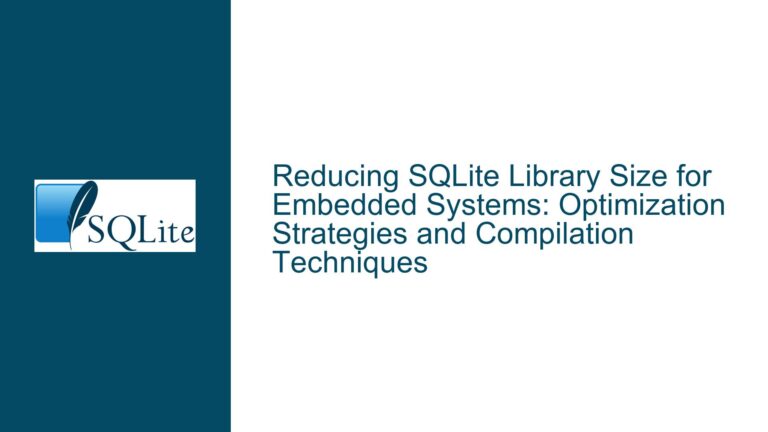Enforcing Query Time Limits in SQLite: Best Practices and Solutions
Issue Overview: Enforcing Query Time Limits in SQLite
Enforcing query time limits in SQLite is a critical requirement for applications that allow users to execute custom SQL queries, especially in multi-user environments or when dealing with large datasets. The primary goal is to prevent long-running queries from exhausting server resources, which can lead to degraded performance or even server crashes. SQLite, being a lightweight and embedded database, does not natively provide a built-in mechanism to enforce query time limits. This necessitates the implementation of custom solutions to interrupt or cancel queries that exceed a specified time threshold.
The core challenge lies in balancing the need for precise time limit enforcement with the overhead introduced by the monitoring mechanism. Additionally, the solution must be robust enough to handle multiple concurrent queries without inadvertently canceling unrelated operations. The discussion highlights two primary approaches: using SQLite’s set_progress_handler method and leveraging the sqlite3_interrupt API. Each approach has its own set of trade-offs, particularly concerning overhead, concurrency, and thread safety.
Possible Causes: Why Query Time Limits Are Necessary and Challenging to Implement
Query time limits are essential for maintaining system stability and ensuring fair resource allocation among users. Without such limits, a single long-running query can monopolize CPU and memory resources, leading to increased latency for other users and potentially causing the system to become unresponsive. In the context of SQLite, the lack of a built-in query time limit feature means that developers must implement custom solutions, which can introduce complexity and potential pitfalls.
One of the primary challenges is the overhead associated with monitoring query execution time. The set_progress_handler method, for example, requires a Python function to be called periodically during query execution. While this approach provides fine-grained control over query cancellation, it can introduce significant overhead, especially when the handler is invoked frequently (e.g., every 1000 virtual machine ticks). This overhead can negate the performance benefits of enforcing time limits, particularly in high-throughput environments.
Another challenge is managing concurrency. Since the set_progress_handler method is tied to a specific SQLite connection, it cannot be used to enforce different time limits for multiple queries running on the same connection. This limitation necessitates the use of multiple connections, which can increase resource usage and complicate connection management. Additionally, the sqlite3_interrupt API, while more efficient, introduces potential thread safety issues, particularly when the connection object is closed while an interrupt is being processed.
Troubleshooting Steps, Solutions & Fixes: Implementing Robust Query Time Limits in SQLite
To address the challenges of enforcing query time limits in SQLite, developers can consider the following solutions and best practices:
1. Using set_progress_handler with Optimized Overhead:
The set_progress_handler method is a viable option for enforcing query time limits, but it requires careful tuning to minimize overhead. One approach is to adjust the frequency of handler invocations based on the desired time limit. For example, if the time limit is relatively long (e.g., 1 second), the handler can be configured to run every 1000 virtual machine ticks. For shorter time limits (e.g., less than 50ms), the handler should be invoked more frequently (e.g., every tick) to ensure precise enforcement.
However, developers should be aware that frequent handler invocations can introduce significant overhead, particularly in Python, where function calls are relatively expensive. To mitigate this, the handler function should be as lightweight as possible, avoiding complex logic or external calls. Additionally, developers can experiment with different values for the n parameter to strike a balance between precision and performance.
2. Leveraging sqlite3_interrupt for Efficient Query Cancellation:
The sqlite3_interrupt API provides a more efficient mechanism for canceling long-running queries. Unlike set_progress_handler, which requires periodic function calls, sqlite3_interrupt allows developers to interrupt a query from a separate thread. This approach reduces overhead and provides more precise control over query cancellation.
To use sqlite3_interrupt, developers should implement a timer mechanism in their application code. When the timer expires, the interrupt method is called on the SQLite connection object. This method is available in the Python sqlite3 library as connection.interrupt(). It is important to note that sqlite3_interrupt is thread-safe, but developers must ensure that the connection object remains valid when the interrupt is called. This can be achieved by using synchronization mechanisms, such as locks or semaphores, to coordinate access to the connection object.
3. Handling Thread Safety and Connection Lifetime:
When using sqlite3_interrupt, developers must be mindful of thread safety and connection lifetime issues. As highlighted in the discussion, there is a potential race condition where the connection object is closed while an interrupt is being processed. To avoid this, developers should implement safeguards to ensure that the connection object remains valid during the interrupt call.
One approach is to use a context manager or a similar pattern to manage the lifetime of the connection object. For example, the connection object can be wrapped in a custom class that ensures the connection is only closed after all pending interrupts have been processed. Additionally, developers can use thread synchronization primitives, such as locks or condition variables, to coordinate access to the connection object across multiple threads.
4. Exploring Alternative Solutions and Future Enhancements:
While the current solutions provide effective mechanisms for enforcing query time limits, there is room for improvement. One potential enhancement is for SQLite to introduce a built-in query time limit feature, similar to the hypothetical PRAGMA query_time_limit command. This would simplify the implementation and reduce the need for custom solutions.
In the meantime, developers can explore alternative approaches, such as using external monitoring tools or integrating with other database systems that provide native support for query time limits. For example, PostgreSQL offers the statement_timeout parameter, which can be used to enforce time limits on individual queries. While this approach may not be directly applicable to SQLite, it can serve as inspiration for future enhancements.
5. Benchmarking and Performance Optimization:
Regardless of the chosen approach, developers should conduct thorough benchmarking to evaluate the performance impact of their query time limit implementation. This includes measuring the overhead introduced by the monitoring mechanism, as well as the latency and throughput of the system under different workloads.
To optimize performance, developers can experiment with different configurations, such as adjusting the frequency of handler invocations or tuning the timer mechanism used with sqlite3_interrupt. Additionally, developers should consider the specific requirements of their application, such as the expected query complexity and the number of concurrent users, when designing their query time limit solution.
6. Best Practices for Implementing Query Time Limits:
To ensure a robust and efficient implementation of query time limits in SQLite, developers should adhere to the following best practices:
- Minimize Overhead: Optimize the monitoring mechanism to reduce the performance impact of enforcing query time limits. This includes using lightweight handler functions and tuning the frequency of handler invocations.
- Ensure Thread Safety: Use synchronization mechanisms to coordinate access to the connection object and prevent race conditions when using
sqlite3_interrupt. - Handle Connection Lifetime: Implement safeguards to ensure that the connection object remains valid during interrupt calls, such as using context managers or custom wrapper classes.
- Benchmark and Optimize: Conduct thorough benchmarking to evaluate the performance impact of the query time limit implementation and optimize the configuration based on the specific requirements of the application.
- Explore Future Enhancements: Stay informed about potential enhancements to SQLite, such as the introduction of a built-in query time limit feature, and consider alternative solutions that may provide additional benefits.
By following these best practices and leveraging the available tools and techniques, developers can effectively enforce query time limits in SQLite, ensuring system stability and optimal performance in multi-user environments.






